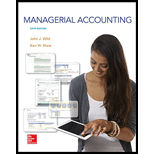
Concept explainers
Concept introduction:
Return on investment is a profitability ratio that represents the percentage return on the investment made. It is calculated by dividing the Net Income by the Average total assets. The formulas to calculate the ROI are as follows:
Profit Margin Ratio:
Profit Margin Ratio is a profitability ratio that represents the percentage income earned on the sales. It is calculated by dividing the Net Income by the Sales. The formulas to calculate the Profit margin is as follows:
Asset Turnover Ratio:
Asset Turnover Ratio is an efficiency ratio that represents the sales earned on the average assets invested in the business. It is calculated by dividing the Sales by Average total assets. The formulas to calculate the Asset Turnover Ratio is as follows:
To calculate:
The Return on investment, Profit Margin, and Investment turnover ratio for each division.
Want to see the full answer?
Check out a sample textbook solution
Chapter 9 Solutions
Managerial Accounting
- hi expert please help mearrow_forwardNeed help with this financial accounting questionarrow_forwardAcp Distributors purchased a cooling system for its storage warehouse at a cost of $92,500. The cooling system has an estimated residual value of $7,000 and an estimated useful life of 10 years. What is the amount of the annual depreciation computed by the straight-line method?arrow_forward
- provide correct answer general accountingarrow_forwardScarce resource; discontinued product lines; negative contribution marginThe officers of Bardwell Company are reviewing the profitability of the company’s four products and the potential effects of several proposals for varying the product mix. The following is an excerpt from the income statement and other data. Total Product P Product Q Product R Product S Sales $62,600 $10,000 $18,000 $12,600 $22,000 Cost of goods sold (44,274) (4,750) (7,056) (13,968) (18,500) Gross profit $18,326 $5,250 $10,944 $(1,368) $3,500 Operating expenses (12,004) (1,990) (2,968) (2,826) (4,220) Income before taxes 6,322 $3,260 $7,976 $(4,194) $(720) Units sold 1,000 1,200 1,800 2,000 Sales price per unit $10.00 $15.00 $7.00 $11.00 Variable cost of goods sold 2.50 3.00 6.50 6.00 Variable operating expenses 1.17 1.25 1.00 1.20 Each of the following proposals is to be considered independently of the other proposals. Consider only the product changes stated in each…arrow_forwardAnalyzing one company's make or buy and special order proposals OneCo is a retail organization in the Northeast that sells upscale clothing. Each year, store managers (in consultation with their supervisors) establish financial goals; a monthly reporting system captures actual performance. OneCo Inc. produces a single product. Cost per unit, based on the manufacture and sale of 10,000 units per month at full capacity, is shown below. Product costs Direct materials $4.00 Direct labor 1.30 Variable overhead 2.50 Fixed overhead 3.40 Sales commission 0.90 $12.10 The $0.90 sales commission is paid for every unit sold through regular channels. Market demand is such that OneCo is operating at full capacity, and the firm has found it can sell all it can produce at the market price of $16.50. Currently, OneCo is considering two separate proposals: · Gatsby, Inc. has offered to buy 1,000 units at $14.35 each. Sales commission would be $0.35 on this special order. ·…arrow_forward
 Cornerstones of Cost Management (Cornerstones Ser...AccountingISBN:9781305970663Author:Don R. Hansen, Maryanne M. MowenPublisher:Cengage Learning
Cornerstones of Cost Management (Cornerstones Ser...AccountingISBN:9781305970663Author:Don R. Hansen, Maryanne M. MowenPublisher:Cengage Learning
